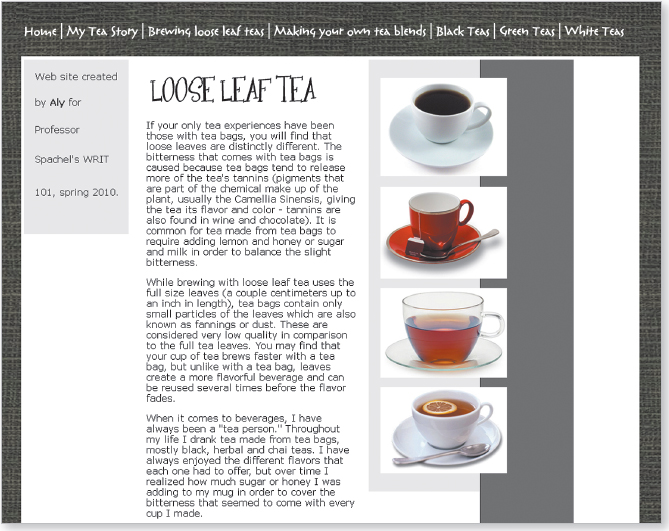MM13-a: Seeking and using feedback
Before you revise and edit, it may help to seek feedback from classmates, your instructor, a tutor, or a friend. Tell each reviewer whether you want feedback about larger, more global issues (organization, main point, use of audio/visual/textual evidence, overall message) or surface-level issues (clear sentences, precise words, sentence logic). In other words, tell reviewers whether you are approaching a revising stage or an editing stage. Before you share a draft with a reviewer, think about three key questions you might want your reviewer to answer, and share those questions with him or her.
After student composer Alyson D’Amato had made initial decisions based on her purpose, audience, and content and after she had outlined and drafted her project, an informative Web site about tea, she met with a tutor at her school’s writing center to get feedback on her site. Figure 13-1 shows a page from her draft site. She asked the tutor the following questions:
- The assignment says that we have to have good navigation —a clear introduction and a way for the reader/viewer to move through the composition. Is the navigation clear? How can I improve it?
- I’m not sure about the pictures I’ve included, but I don’t know what I would replace them with. Can you comment on the visuals?
- Do you think that the text is well written and flows well? Can you point out areas that could be stronger?
D’Amato and her tutor spent some time looking at her site, and the tutor had D’Amato read parts of it out loud. They also looked at a few other informative Web sites for ideas and inspiration. D’Amato left with a set of priorities for revising her work. The following are her revision goals.
alyson d’amato’s revision goals
- There’s too much to read on each page. Streamline. We looked at another Web site with similar navigation but more manageable content. We came up with a way to break up the text.
- The tea photos are cool, but they don’t really make sense, especially since one has a tea bag in it and my site is about brewing loose leaf teas. Maybe replace with images of loose leaf tea.
- The tutor also asked why I chose the font for “LOOSE LEAF TEA,” and I just thought it looked cool. We looked at some other tea sites, and they all used a more elegant type of font that might be easier to read and more appealing to people interested in tea. Choose new font.
- The site will need more of an introduction—the tutor said I just jumped right into it here. There are also chunks of info that don’t really fit or flow well. I marked those and need to revise them. NOTE TO SELF!!! Do this before reworking the text on different pages!
- The tutor also asked why I took up so much room on the left side with my name and class info. He suggested that because my audience is potential tea fans generally, I might want to cut the class-specific info, because it really makes this look like a student project, which some people might not take seriously.
Creating a list of goals is a good way to make the transition between feedback and revising. Keep in mind that you don’t have to make every change a reviewer suggests. Look at the reviewer’s suggestions through the lens of your own purpose, audience, and assignment. Not every suggestion is going to be right for your project. If you seek feedback from three reviewers, however, and all three say that your project seems a little hard to follow, you know that organization is going to be one area in which you’ll want to focus your revision efforts.
